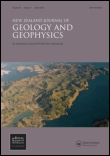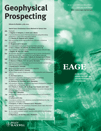
Bulletin of Geophysics and Oceanography
Scope & Guideline
Unlocking the Secrets of Our Planet's Oceans and Atmosphere
Introduction
Aims and Scopes
- Geophysical Analysis and Interpretation:
The journal emphasizes research that employs geophysical methods, such as seismic, magnetic, and gravity surveys, to interpret subsurface geological structures and processes. - Oceanographic Studies:
It includes studies on ocean circulation, hydrothermal systems, and the interaction between geological and oceanographic processes. - Innovative Methodologies:
The journal promotes the use of advanced computational techniques, including machine learning and neural networks, for data analysis and interpretation in geophysics. - Environmental and Geological Hazards:
Research addressing the assessment and monitoring of natural hazards, including earthquakes, landslides, and their impacts on the environment and infrastructure. - Resource Exploration and Management:
The journal covers studies related to the exploration and management of natural resources, such as hydrocarbons and minerals, using geophysical methods.
Trending and Emerging
- Machine Learning and AI Applications:
There is a growing trend towards the application of machine learning and artificial intelligence in geophysical data analysis, enhancing the accuracy and efficiency of interpretations. - Integrated Geophysical Approaches:
Research increasingly emphasizes the integration of multiple geophysical methods to provide comprehensive models of geological structures, reflecting a multidisciplinary approach to geophysical research. - Climate Change and Environmental Monitoring:
Emerging themes focus on the impact of climate change on geological and oceanographic phenomena, highlighting the need for monitoring and assessment tools to understand these changes. - Geophysical Monitoring of Infrastructure:
There is an increased focus on the use of geophysical methods for monitoring structural integrity and assessing risks related to infrastructure, indicating a practical application of geophysics in civil engineering. - Hydrocarbon and Mineral Resource Management:
Research on advanced techniques for resource exploration and management, particularly in relation to hydrocarbons and minerals, continues to gain traction, reflecting ongoing global resource demands.
Declining or Waning
- Historical Seismology:
Research focusing on historical seismic events, while still relevant, appears to be less frequent in recent publications, possibly due to a shift towards contemporary monitoring and real-time analysis techniques. - Traditional Geophysical Methods:
There is a noticeable decline in papers focusing solely on traditional geophysical methods without integration of advanced technologies, as the field moves towards more innovative approaches. - General Environmental Studies:
While environmental studies remain important, there is a decrease in general papers not specifically tied to geophysical or oceanographic applications, as the journal narrows its scope to more focused topics.
Similar Journals

Acta Geophysica
Innovating Insights into Earth's Dynamic Processes.Acta Geophysica is a distinguished peer-reviewed journal published by Springer International Publishing AG, focusing on the dynamic field of Geophysics. With an ISSN of 1895-6572 and an E-ISSN of 1895-7455, this journal stands as a critical platform for disseminating cutting-edge research and advancements from 2006 to 2024. Acta Geophysica maintains a respectable impact factor, reflecting its contribution to the global scientific community, where it ranks in the Q2 category within Geophysics, and is positioned 55 out of 165 in Scopus' Earth and Planetary Sciences, placing it in the 66th percentile. Based in Switzerland, the journal invites submissions that address a diverse range of topics, including seismic studies, geodynamics, and climate change impacts, thereby fostering in-depth discussions and innovative solutions in geophysical research. Access to the journal's content is offered through subscription-based options, ensuring a sustainable model for high-quality scientific exchange. By connecting researchers, professionals, and students, Acta Geophysica plays a vital role in advancing the understanding of Earth's processes and contributing to the field's evolution.

Geofizicheskiy Zhurnal-Geophysical Journal
Illuminating Complex Geophysical ChallengesGeofizicheskiy Zhurnal-Geophysical Journal, published by the esteemed S I Subbotin Institute of Geophysics, National Academy of Sciences of Ukraine, stands as a vital resource for professionals and researchers in the field of geophysics. With an ISSN of 0203-3100 and an E-ISSN of 2524-1052, this journal is recognized for its rigorous peer-reviewed articles that delve into various aspects of geophysical research, including seismic studies, geodynamics, and Earth surface processes. Although currently not under an open access model, the journal maintains a commitment to disseminating high-quality research, thereby enriching the global geophysical community. The publication aims to foster collaboration and knowledge transfer among scientists and engineers while addressing complex geophysical challenges in a rapidly evolving landscape. By engaging with cutting-edge research, readers can expect to uncover insights that advance both theoretical understanding and practical applications in geophysical science.

Geology Geophysics and Environment
Unveiling Insights into Our Planet's Dynamics.Geology Geophysics and Environment, published by AGH University of Science & Technology Press, is a prominent, open-access journal that has been disseminating knowledge since its inception in 2012. With its ISSN 2299-8004 and E-ISSN 2353-0790, this scholarly journal serves as a vital platform for researchers, professionals, and students interested in the interdisciplinary fields of geology, geophysics, and environmental science. By providing unrestricted access to a wide array of high-quality research articles, Geology Geophysics and Environment facilitates the sharing of innovative ideas and advancements that address some of the most pressing challenges in earth sciences today. Recognized for its contributions to the field, this journal is crucial for anyone looking to stay abreast of the latest trends and discoveries in the dynamic landscapes of geology and environmental research.

NEW ZEALAND JOURNAL OF GEOLOGY AND GEOPHYSICS
Deepening Understanding of Earth's Dynamic Systems.NEW ZEALAND JOURNAL OF GEOLOGY AND GEOPHYSICS, published by Taylor & Francis Ltd, stands as a prominent forum dedicated to the interdisciplinary exploration of geological and geophysical phenomena. With an impact factor that situates this journal in the prestigious Q1 category across key subjects—namely Earth and Planetary Sciences, Geology, and Geophysics—it is a critical resource for researchers, professionals, and students alike. The journal has been operational since 1958 and continues to contribute valuable insights into the complexities of the Earth's processes. Although it does not currently offer Open Access options, its broad readership benefits from an extensive archive of high-quality research findings that span from 1958 to 2024. Located in the United Kingdom, the journal remains a pivotal player in advancing the understanding of Earth's systems, making significant contributions to both academic inquiry and practical applications in the field.

Geodynamics
Charting New Territories in Geophysical ResearchGeodynamics is an emerging scholarly journal published by LVIV POLYTECHNIC NATIONAL UNIVERSITY, dedicated to advancing knowledge in the fields of Earth and Planetary Sciences, with a particular emphasis on Geophysics, Geology, and related specialties. Featuring both ISSN 1992-142X and E-ISSN 2519-2663, this journal aims to publish high-quality research that addresses critical challenges in geodynamic processes and their implications on our planet's systems. Despite its nascent status, having converged years from 2023 to 2024, Geodynamics is poised to attract attention in the academic community, especially as evidenced by its rankings in Scopus, which position it prominently within the discipline. The journal's commitment to open access ensures that cutting-edge research is readily available to the global scientific community, fostering collaboration and innovation. Researchers, professionals, and students will find Geodynamics an essential resource for the latest findings and discussions in geodynamics and related fields, making it an invaluable addition to the landscape of environmental science journals.

Geofisica Internacional
Elevating Research Standards in Geophysics Since 1975Geofisica Internacional, an esteemed academic journal published by the Instituto de Geofísica at UNAM, Mexico's prestigious National Autonomous University, has been a pivotal platform for advancing the field of geophysics and energy studies since its inception in 1975. This Open Access journal aims to disseminate high-quality research findings, making significant contributions to our understanding of Earth's processes and energy resources. With a current impact factor that situates it in the Q3 category for both Energy (miscellaneous) and Geophysics, it provides a continuous dialogue for researchers, professionals, and students interested in the intersection of these critical areas. Based in Mexico City and publishing articles that span various geophysical disciplines, Geofisica Internacional is indispensable for anyone seeking to stay at the forefront of environmental and energy research.

GEOPHYSICAL PROSPECTING
Exploring the Depths of Geophysics and GeochemistryGEOPHYSICAL PROSPECTING is a premier journal published by Wiley, dedicated to the fields of geophysics and geochemistry. With an impressive impact factor, it holds a notable place in academic circles, boasting a ranking of Q1 in Geophysics and Q2 in Geochemistry and Petrology for 2023. The journal, ISSN 0016-8025 and E-ISSN 1365-2478, features cutting-edge research addressing key challenges in understanding the Earth's structure and processes. It has been an influential platform since its inception in 1953 and continues to converge towards its goal of disseminating integral geophysical advancements through 2024. Although not open access, researchers can benefit from its wealth of high-quality articles, substantiated by commendable rankings of 41st in Geophysics and 53rd in Geochemistry and Petrology. From its headquarters in the United Kingdom, GEOPHYSICAL PROSPECTING not only contributes to the theoretical advancement of these fields but also aids practical applications in environmental exploration and resource management, making it an essential resource for researchers, students, and professionals alike.

Solid Earth Sciences
Advancing our understanding of Earth's hidden depths.Solid Earth Sciences is a dynamic open-access journal published by Elsevier, dedicated to advancing our understanding of the Earth's subsurface processes and materials. Since its inception in 2016, the journal has established itself as a vital resource for researchers and professionals in the fields of geochemistry, petrology, geology, geophysics, and geotechnical engineering, achieving a notable Q2 ranking in multiple categories as of 2023. With an ISSN of 2451-912X, the journal aims to disseminate high-quality research that enhances knowledge of earth surface processes and the intricate interactions within our planet's systems. The journal is indexed in Scopus, showcasing an impressive rank in various sub-disciplines, with a rank of #96 in Geology and a noteworthy percentile in Earth and Planetary Sciences. Solid Earth Sciences offers a platform for innovative studies, comprehensive methodologies, and cutting-edge technological advancements that cater to a global audience of scientists, academics, and students. With its commitment to open access, it fosters wider dissemination and impact of research outcomes, ensuring that pivotal discoveries reach stakeholders and contribute to real-world applications.

Science China-Earth Sciences
Advancing Knowledge in Earth and Planetary Sciences.Science China-Earth Sciences, published by SCIENCE PRESS, stands as a leading journal in the field of Earth and Planetary Sciences, currently holding a prestigious Q1 ranking in the 2023 category and positioned at Rank #12 out of 195 in Scopus, reflecting its significance with an impressive 94th percentile. Specializing in a wide array of topics including geological processes, environmental science, and planetary studies, the journal serves as a vital resource for researchers, professionals, and students alike, fostering interdisciplinary collaboration and advanced scientific discourse. With a commitment to accessibility and knowledge dissemination, Science China-Earth Sciences offers an Open Access model, ensuring that high-quality research is available to a global audience. Situated in Beijing, China, this journal is dedicated to promoting innovative scientific advancements and understanding the complexities of our planet from 2010 to 2024 and beyond. As such, it remains essential for anyone engaged in the dynamic and evolving field of Earth sciences.

Russian Journal of Earth Sciences
Advancing knowledge in Earth and Planetary Sciences.Russian Journal of Earth Sciences, published by the esteemed Geophysical Center RAS, is a pivotal resource for researchers and professionals in the field of Earth and Planetary Sciences. With an ISSN of 1681-1208 and an E-ISSN of 1681-1208, this journal has demonstrated a significant trajectory since its inception in 1998, currently converging towards its 2024 goal of disseminating innovative research. The journal holds a respectable position within the academic community, ranked Q3 in Earth and Planetary Sciences by Scopus, placing it at the 44th percentile among the most relevant journals in the field. Though it operates under a traditional access model, its commitment to advancing scientific knowledge ensures that vital research findings are available to a global audience. Located in Moscow, Russian Federation, the journal not only serves as a platform for high-quality research but also fosters a collaborative environment for scholars aiming to contribute to the understanding of our planet's geological phenomena.